What we played with in our formative years … with some broadcasting anecdotes interposed.
Albert Barber
I found this the other day: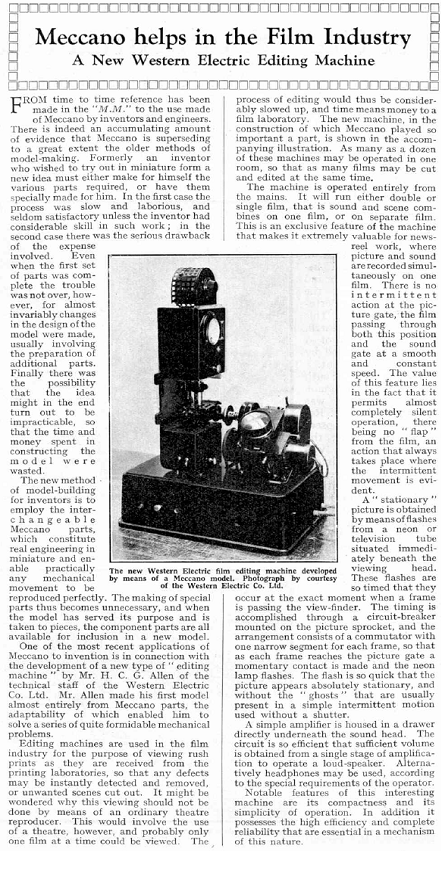
[Ed: part enlarged to make it easier to read]
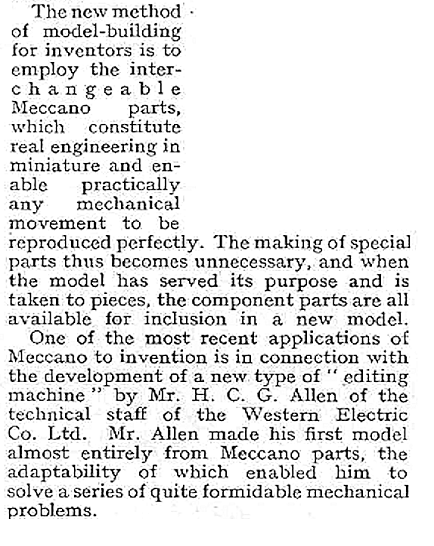
Graeme Wall
Somehow Lego doesn’t work quite so well…Alan Taylor
When I was a kid, I loved Meccano and ended up buying a second hand number 9 kit and the getting lots of extra parts. The secret weapon amongst all this stuff was a complete set of instruction manuals, including some that were printed for special display projects.The reason why I was able to get those manuals was because my dad was a compositor at a printing company which had the contract for making all those manuals. If you encounter an original Meccano instruction manual from the 1950s and look at the bit that we might call the closing credits, you should find the letters B&M, which stood for Balding & Mansell. I was very disappointed that B&M didn’t also have the contract for printing the monthly Meccano magazine. This was because monthly magazines required a different printing process with a specialised workflow.
Albert Barber
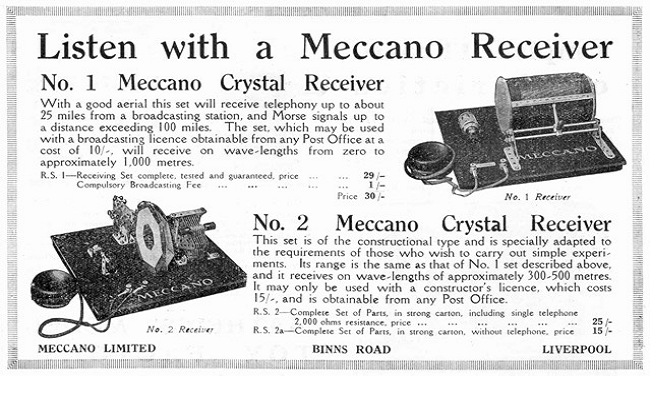
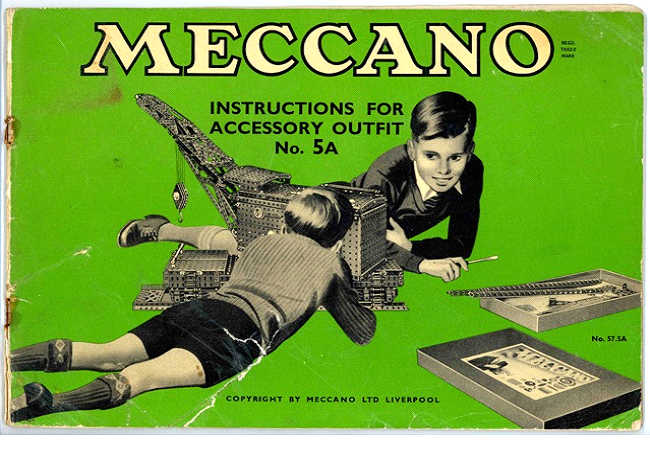
Alan Taylor
My proudest Meccano achievement was when I completed the walking dragline crane, which is shown on many covers of manuals. Many years later I was driving through Northamptonshire and had to stop the car, turn round and check whether my eyes were deceiving me. It was the real thing and looked remarkably similar to the thing I toiled so hard to build. My wife (at that time) was distinctly unimpressed.Prompted by Albert’s fascinating pictures, I found a site which was a collection of Meccano manuals, but I didn’t spot any with the little B&M mark which my dad used to point out to me, but they seem to contain the same projects.
Dave Newbitt
Was this the one Alan – Ransomes & Rapier W1400? This model was built by one Colin Davies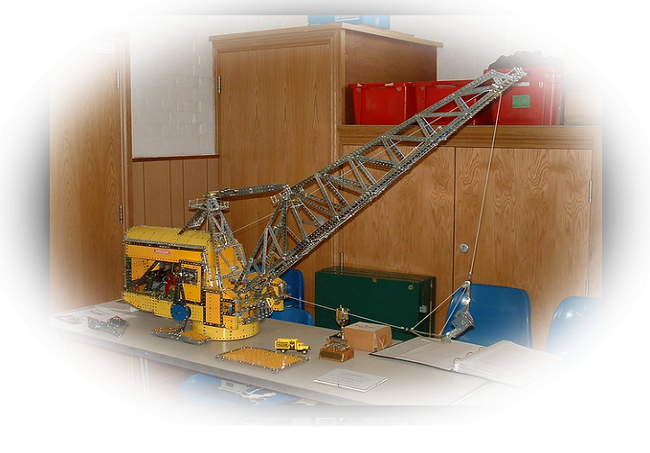
I loved it!
Alan Taylor
Yes, that’s the one although mine was in red and green. It really could walk along or maybe shuffle along, lifting itself up on its feet, lurching forward and then sitting down again on its base before lifting its feet forward again.The real version looked incredibly imposing, but sadly wasn’t working when I spotted it.
A much smaller model which I built and later in life recognised the real thing was a Jumbo crane. I did a show on an army camp and they had one driving around picking up stuff. I instantly knew what it was because it had a very distinctive parallelogram arm arrangement.
As for model railways, my dad decided that I wanted an electric railway and got me a Hornby Dublo 3 rail railway, if I remember correctly, one loco was the “Duchess of Atholl”. We built it up into quite a complex layout, but I wasn’t very interested in playing with it, just building it. When it was obvious that it was not my sort of thing, we sold it and the money was put towards that fabulous second hand Meccano set which I seldom left alone for long.
My best friend’s dad was an architect and he didn’t reckon much to model railways or Meccano. He decided that his son wanted a Bayko house building set. The dad loved building lots of variants of between the war styles of houses, but my friend didn’t much care for it. I liked playing with it once in a while, but it wasn’t terribly satisfying as you could only build variations on a theme, while Meccano could be used to make a massive variety of things. I believe that Bayko was eventually bought out by Meccano.
Dave Newbitt
Throughout my boyhood Meccano was my favourite pastime by a mile. I started with a No.5 set, my main Christmas present when I was five. I remember effort number one was a flange plate, two spindles/axles and 4 rubber tyred wheels. I proudly trudged up the road to my pal’s house clutching this masterpiece to find that he too had been given Meccano but a much larger set which his father had already converted into a huge gantry crane which articulated, jibbed, raised and lowered its block and tackle etc. etc. One of my earliest recollections of feeling utterly crushed!The following year saw my version upgraded to a No 6 set, but thereafter I concentrated more on acquiring things like motors and gears. The gears fascinated me with straight cut, bevel, helical, worm, contrate etc. and I used to construct things like differentials so that I understood from quite a young age how such things worked. Gear reduction trains to achieve increasing torque were another obsession as I attempted to get a simple wheeled platform up ever steepening gradients, learning along the way that frictional losses meant there was a limit to how far you could push the idea.
In my early teens we lived a few doors from a terminally ill lad and my mother persuaded me that it would be a wonderful gesture to give him my Meccano. Like some other expansive gestures I look back on, I wonder if I got it right!
Would have envied your No 9 set Alan, a proud possession indeed. There is currently an unused No 10 set on eBay at £8,699. How’s the bank balance looking!
Alasdair Lawrance
Another Meccano aficionado, and that plus Dinky toys was my world for quite some time.(From memory). Why did the holes in the large clockwork motor frame not match up in pitch or diameter with the standard pieces? Was it meant to be part of the ‘gears ‘ accessory outfit?
Alan Taylor
I think you’re right about the funny hole spacing. From memory, they were on a half inch pitch, but some gear combinations required non standard spacing. The other way to accommodate strange spacing was to arrange triangular structures so that holes could be at the appropriate pitch.My old Meccano set was borrowed by my younger brother when he had children. They didn’t show any interest in it and after a few years he disposed of it because it was taking up too much room, which really pissed me off.
Bit of trivia – I was told by an uncle who used to fly Lysander aircraft during the war that the entire tailplane assembled was fastened to the fuselage by three aviation grade 4 BA bolts. Meccano users might recall that the nuts and bolts were 4 BA. I think I’d be a bit wary about an aircraft if I knew that such an important part was only held on by posh versions of Meccano bolts, but he insisted that they were entirely appropriate for the task and that you wouldn’t want to use anything heavier so far away from the centre of gravity.
Chris Woolf
A high grade (10.9) M4 bolt (which is close to a 4BA) has a sheer strength of around half a ton – amazing, I know, but high tensile steel is pretty good stuff.Dave Plowman
I was given a used Meccano set by a pal of my father. My older brother already had Trix.It may well have been pre WW2 and was gold and blue – the blue plates having a gold cross hatch on them. And was missing the flange plate – the base for so many models. But formed a basis for me to build up on.
I credit Meccano with my not being scared of taking anything apart to fix it. Even when not always successful.
Alan Taylor
My second-hand Meccano kit also had some of those vintage blue and gold cross hatch panels. I thought they looked pretty cool. There were a load of other curious parts which didn’t appear in post-war catalogues, but were quite useful, however most of the parts were from the 1950s.I was lucky enough to have three big electric motors which used field windings rather than permanent magnets. I designed and built a special power supply with switches to control the speed and direction of each motor, based on a multi-tapped transformer similar to the official Meccano one, but adapted from a salvaged transformer where all the wiring was stripped off except for the original mains primary coil and new tapped secondary windings were made.
The first problem was that the cheap rotary switches I bought from Henry’s Radio couldn’t handle anything like the surge currents from the motors and the switches vaporised most spectacularly. I ended up making rotary switches out of studs and spring contacts salvaged from some military surplus equipment.
The second unexpected problem was that if you reverse the polarity to a motor with field coils, it still runs in the original direction, which is not all that surprising when you remember that it was running on AC power. I hadn’t realised that the way I had read about controlling motors with permanent magnets wasn’t applicable to these motors and didn’t think to experiment before building the awesome, triple output power control device.
The motor itself had a sort of switch plate on the front allowing it to run forwards or backwards by changing the polarity of the field coils relative to the armature. The control plate had holes for bolts so that it could be operated by Meccano components or linkages.
My dreams of operating a James Bond villain style of control panel were not going to be possible until such times as permanent magnet Meccano motors became available, but by then I was interested in other things, such as model aircraft, tape recorders and then young ladies.
Looking back, my understanding of power handling, motor types and electrical safety was somewhat lacking in those days. My understanding of young ladies was no better either, but the failed experiments were more fun.
Pat Heigham
More toy nostalgia:Injured by Meccano – it fought back!
On the voyage to Singapore, to join my Dad at his army base there, I trod on the Meccano screwdriver which was propped up on a ruck in the carpet. The ship’s MO had to gently extricate it, and patch me up – I have a dent in the sole of my foot to this day.
The mention of Lego reminded me that I had a construction kit called Minibrix. This was a forerunner to Lego, the little rubber bricks had a stud and socket system to join them up.
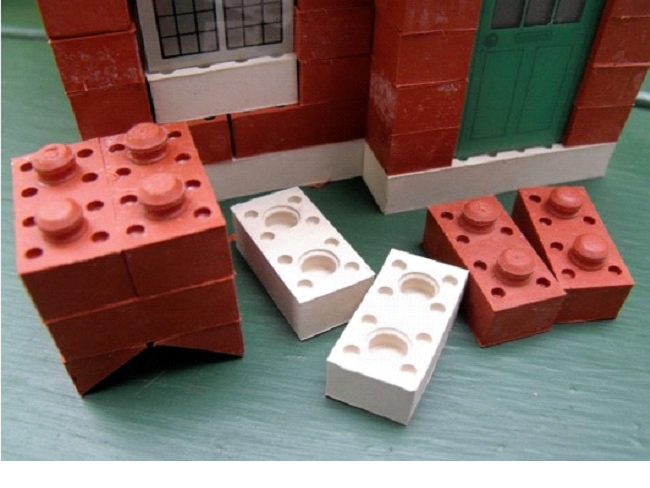
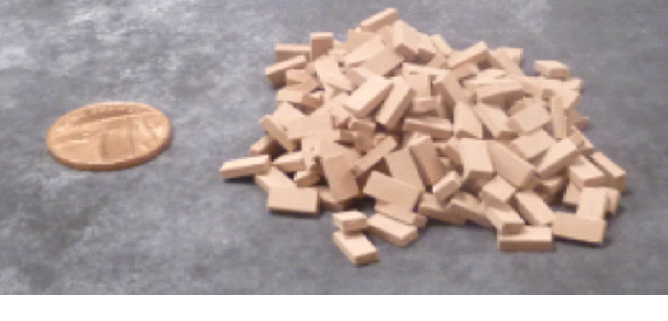
Trevor Vaisey
The recent postings about Meccano reminded me of my various attempts at building TV equipment out of my kit.I had started of with a No 6 and progressed, via various Christmas add-ons, to a No 9, plus one or two bits. Never did make the sought after No 10 though!
The picture is from the August 1953 edition of the “Meccano Magazine”.
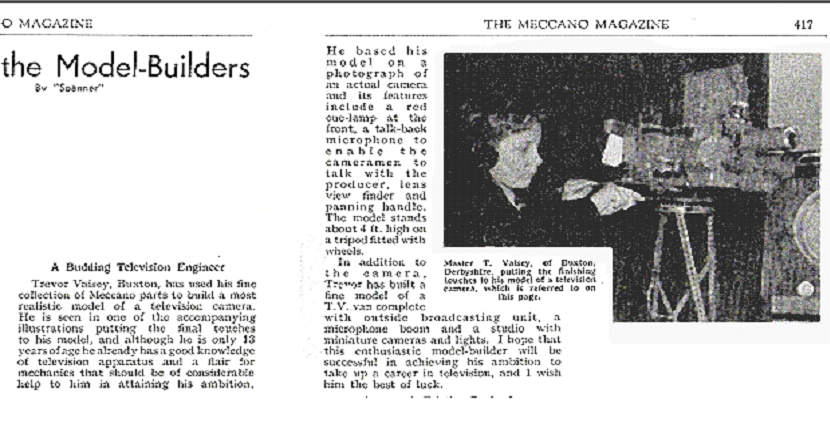
Dave Newbitt
Brilliant! If that was mine I would consider it amongst my finest achievements. It reminds me how much trouble I had returning flexible plates to true flatness after curving them for boilers etc.Alasdair Lawrance
You are not alone, Dave!Alec Bray
One of the first things I had to do, when I went to college in Liverpool after leaving the BBC, was a pilgrimage to Binns Road. Although the factory in Binns Road did not close until 1979, already by then (1967) Hornby had been taken over by Triang, and it just was not the same…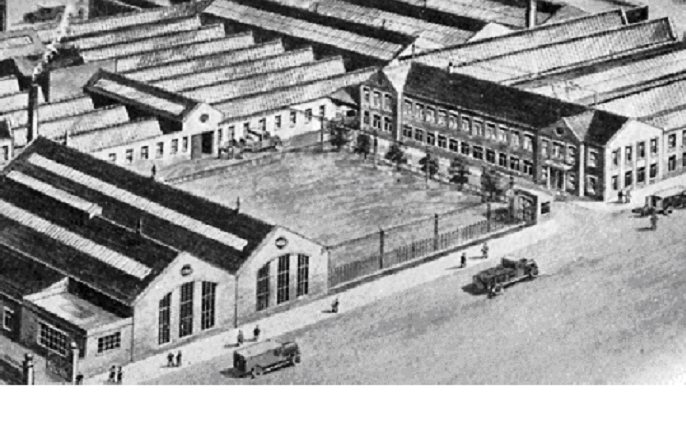
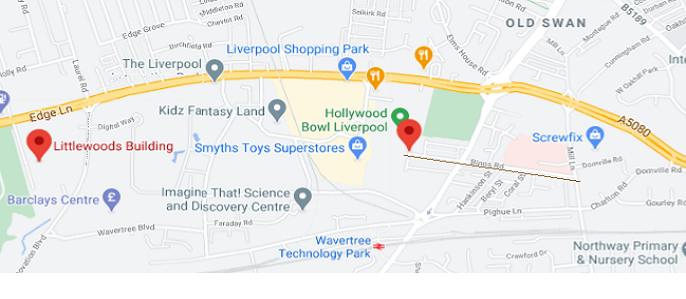

I really liked Meccano, but… whenever I tried to make “proper” Ackermann steering for my buses – or whatever – the wheels simply splayed out : most disheartening. But one of my troubles with Meccano magazine was that I would see a picture of a nice “thing” and I would try to make it from the picture, which was almost always doomed to fail!
“Meccano Magazine”, “The Eagle”, and the “Beano” – wonderful.
Pat Heigham
I mentioned earlier that I stepped on the Meccano screwdriver on the way to Singapore by boat.When Mum and I arrived, my Dad who had been out there a year earlier had put his spare change into a Players cigarette tin, for my pocket money, which I spent in Robinson’s, a department store in Raffles Square, the like of which we had never seen in the UK. I came away with a Bayko building set.
Later a Hornby Dublo Goods was my first electric train set.
On arrival back in the UK, our neighbour in the Isle of Wight was the head of a family that owned several bike and toy shops around the Island. Visited his main shop to buy the “Duchess of Montrose” (still in my loft and working!). I was used to haggling prices, having learned down Change Alley in Singapore – he was so amused that he let me have it for what I was prepared to pay!
Mentioning “Eagle” – at prep school, my folks sent me “Beano”, “Dandy”, “Hotspur”, “Rover” and “Eagle”, but the headmaster eventually only permitted “Eagle”. But the exploded diagrams in the centre spread were fantastic, weren’t they? (Although I was more amused by Desperate Dan and his cow pie!).
My school in Leatherhead had a super outdoor Gauge 1 model railway club, running clockwork, electric and steam locos, and I had what I thought was a Gauge 1 Bing 4-6-2 clockwork loco. It overlapped the track, so was actually Gauge 2!
Some of you will remember Roger Davies, who was a Television Centre Technical Assistant. He had a business in my village, repairing antique clocks, but also looked after my school’s clockwork locomotives, and a pocket gramophone that I have.
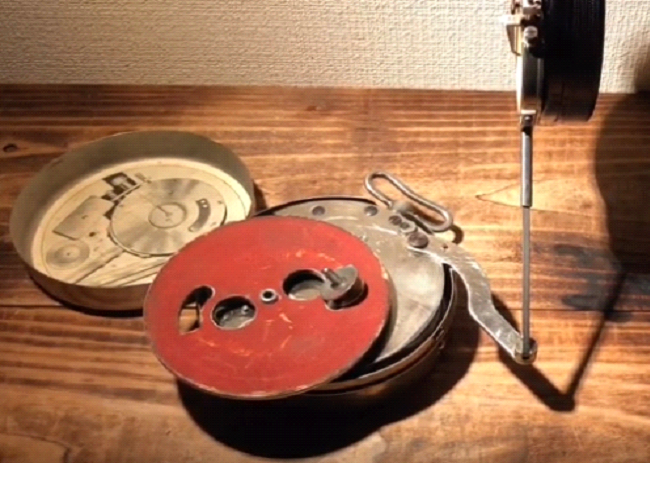
Sadly, during one summer holiday, local oiks broke in to the school grounds and totally trashed the outside layout. It was never rebuilt.
Membership of this Railway Soc was dependent on doing something constructive. I discovered a dusty mail coach, which would put out the collector net, activated by a solenoid lever in the tracks, and shut again if the mail bag was heavy enough. Looking for a source of lead to weight the bags, I melted down my collection of Brittains Royal Marine band musicians! Sacrilege! I should have pinched the lead off the chapel roof!
Nick Ware
Here’s a picture from the front page of the Surrey Advertiser rather a long time ago. That’s me shovelling coal into the loco, aided by two not-to-scale old blighters in greasy caps. And I got to take the driver’s seat with passengers on board, up and down about 50 yards of track. Supervised, of course. We have front view pix somewhere here too, if only I could find them. (Umpteen boxes of old pix, yet to be scanned). I still remember boasting at school that I’d driven a steam locomotive (every schoolboy’s greatest ambition), but didn’t mention that it was a model! (Guildford Model Railway Society, in Stoke Park, Guildford).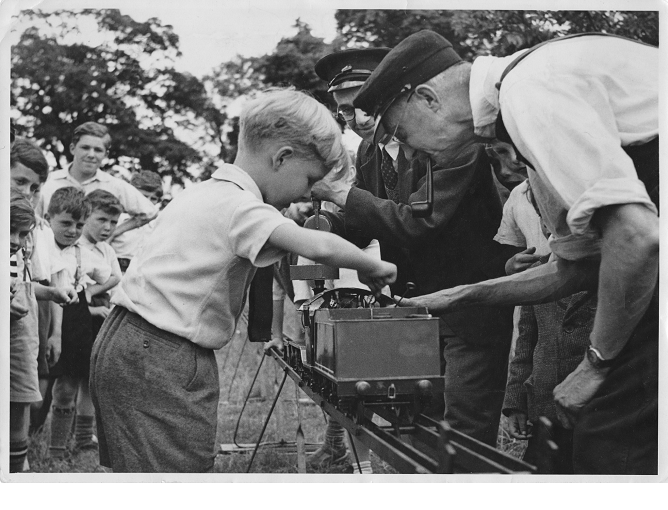
David Newbitt
Your picture, Nick, reminds me of what I think is perhaps my favourite railway photo. It was taken at Waterloo in 1924 and I believe is quite well known/famous.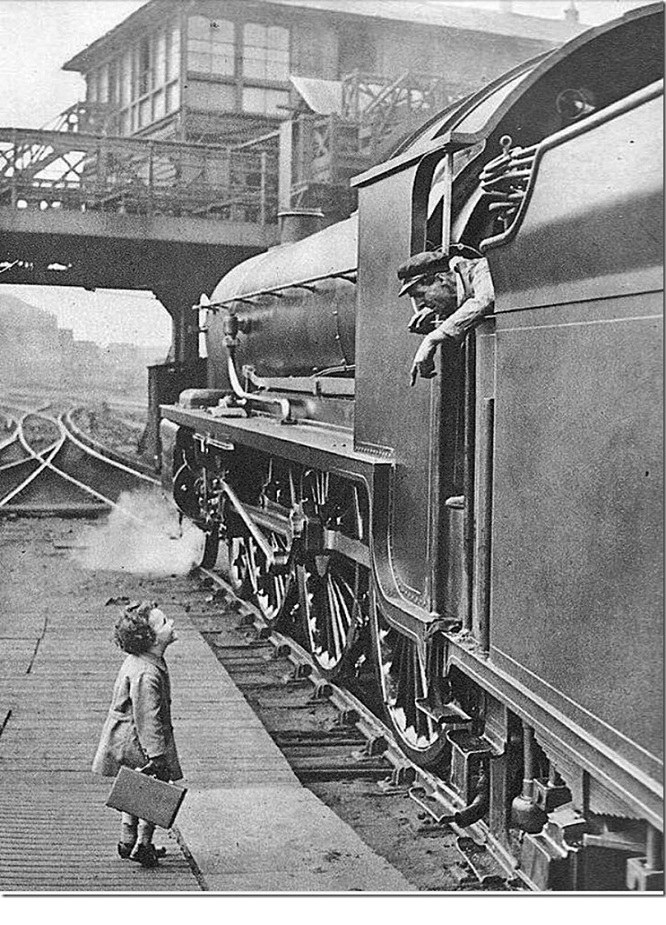
Robin Sutherland
The photo was used in what became the Southern Railway’s most famous railway poster.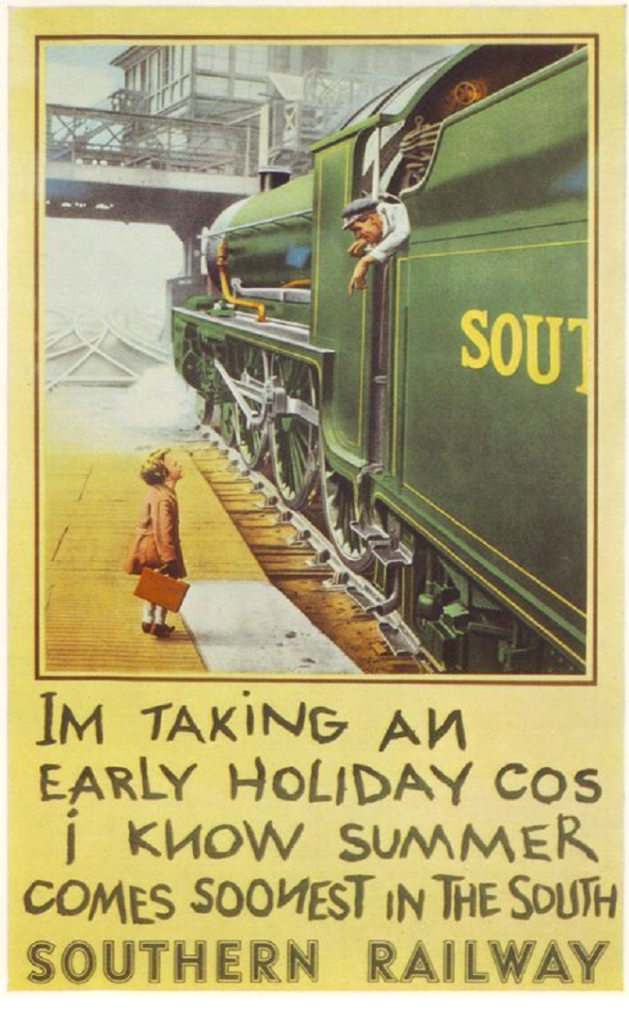
Dave Buckley
In the early 1980s. I did a couple of weeks in Plymouth as a holiday relief station assistant, working on the then early morning radio programme, “Morning Sou’west”.One day O. S. Nock, the railway author came in to be interviewed about another book he had just had published.
I mentioned that I had just finished reading “Line Clear Ahead” by him, to which he admitted that it was mostly an autobiography. From what I remember of the book, there was a modified version of the Waterloo poster used for a dinner given by a professional organisation for him – the caption reading ‘No you can’t come up on the footplate. Who do you think you are, O. S. Nock?’
I’ve had a look through my reading matter and I no longer have the book – I had a cull when I moved house about 20 years ago.
Alec Bray
Ho hum…Here is my 5 inch gauge GWR 14xx tank, built from a kit:
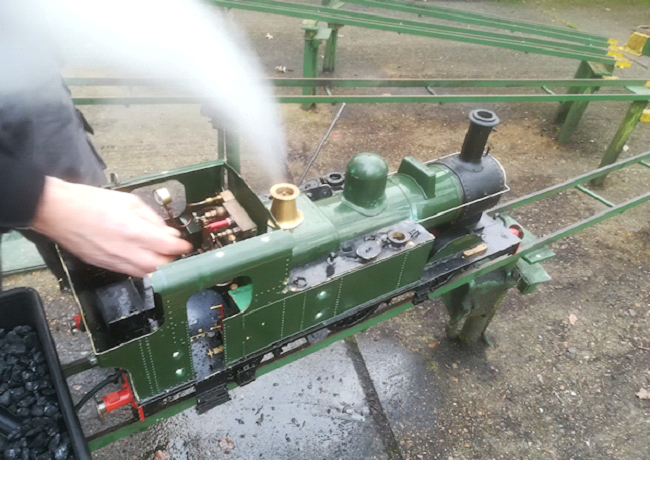
Meanwhile, the “00” gauge layout has been progressing – all the track is now laid in position. It needs fettling (sorting out the solder joints) and adding sleepers by the baseboard joints, then ballasting, wiring, point motor installation…
The picture below was taken some three weeks before the completion of the track laying and shows the fiddle yard under construction. You can see both the narrow gauge line and the standard gauge lines. I had to have the narrow gauge section: I just love the Lynton and Barnstaple railway…
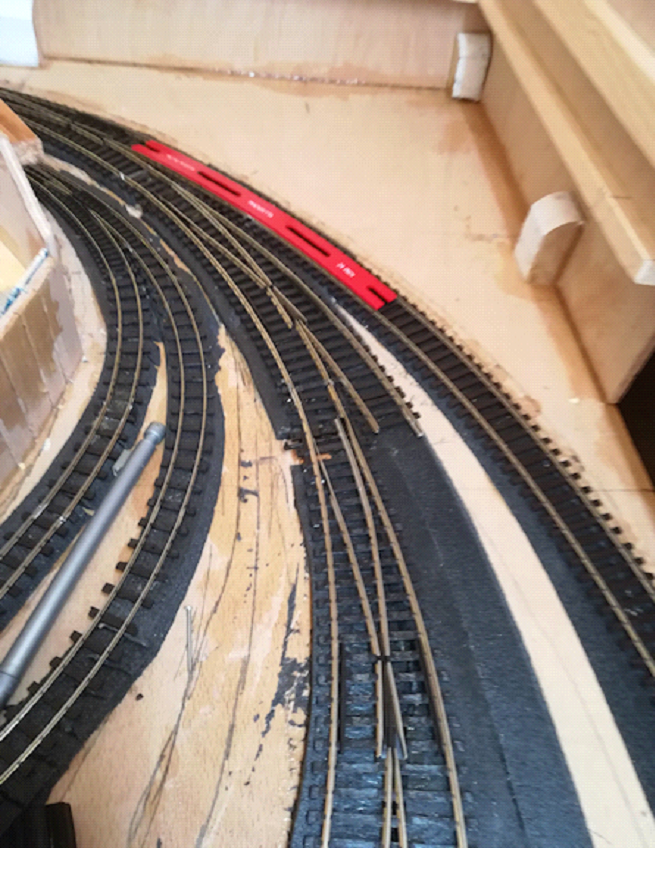
Nick Ware
To me, the hallmark of excellent kit building is improvisation and adaptation as you go. That way, you can discover the shortcuts the designer made to simplify production or cut manufacturing costs, and you can either screw it up or improve on it!This table-top chamber pipe organ kit consisted of many hundreds of pre-prepared flat pack components.
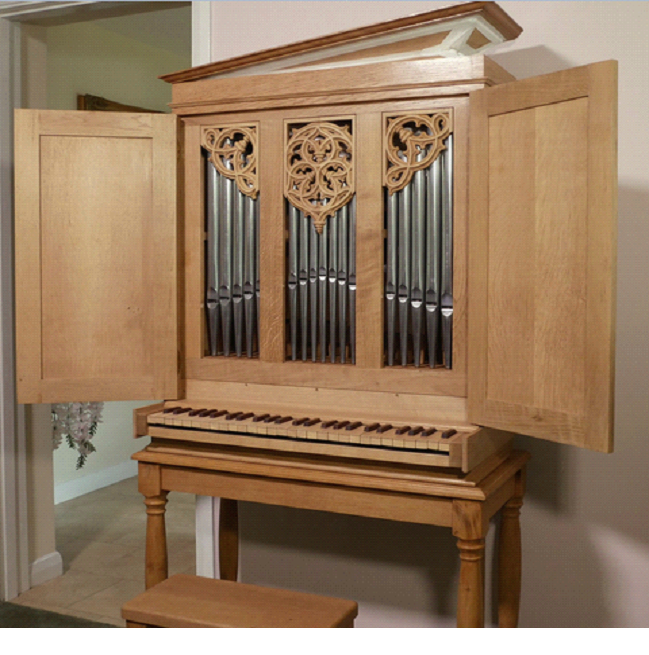
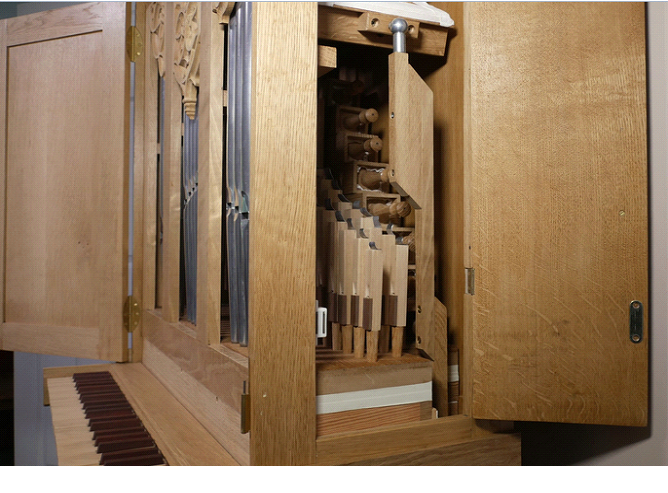
=======================
The most elaborate “00” layout I ever saw was while we were travelling around the country doing competitor profile inserts for “MasterChef “(Loyd Grossman era).
One of our subjects lived in a biggish detached house with a relatively high pitch fully boarded loft space. The loft was completely filled with his 00 layout which included every scenic detail to absolute perfection, and was a seriously complex layout. Two tracks disappeared into a tunnel that ran through a long duct into his neighbour’s loft. The neighbour had a similar layout, and they had computerised the whole setup so that they could run scheduled train journeys into and around each others’ tracks. There would be a number of trains running at once, often on the same bit of track, points changing to let them through as needed, etc. Just like real signalling, etc. It was mighty impressive, although we did wonder if he had a life outside that loft.
I don’t remember now whether his cooking skills matched his railway modelling skills.
Pat Heigham
Very impressive and your building skills amazed me when you constructed a TV camera,Plus, I believe you made a C12 mike?
Has your brother-in-law played the table-top organ?
Nick Ware
I don’t have any pix of the C12, sadly. That project came out of a chat with Peter Eardley at Polytechna (the then UK distributor for AKG). Peter gave me a duff CK12 capsule to take to bits and see if we could simplify it. They told us we could make three as an experimental project without breaching patents. I got Robin Luxford involved, who had a super-precision model maker’s lathe; and Johnny Milner, who had more patience with fiddly tasks than I did, to do the capsule assembly. Robin made jigs for super-accurate drilling the hard Ali centre plate (dozens of 0.35 mm holes) and Perspex insulator rings, and for stretching and gluing the Melinex diaphragms. Milling the rings was a masterpiece of lathe-work on Robin’s part, that took incredible care and acquired skill. I did the rest – electronics, casework, etc. We built three, and I eventually passed mine on to Derek Miller-Timmins, who said he would build me a clavichord, but never did. They were pretty good mics, considering that we simplified the capsule construction somewhat. Not long after that, AKG simplified the CK12 way too complex capsule design along the same lines as ours. Isn’t customer feedback a wonderful thing?! Ours was very similar to the early C414b-ULS. I’d love to know where they are now.I sold the little table organ when we moved house. I was told I could only keep one, so I kept the bigger of the two (the bigger one was mostly my build over about 12 years).
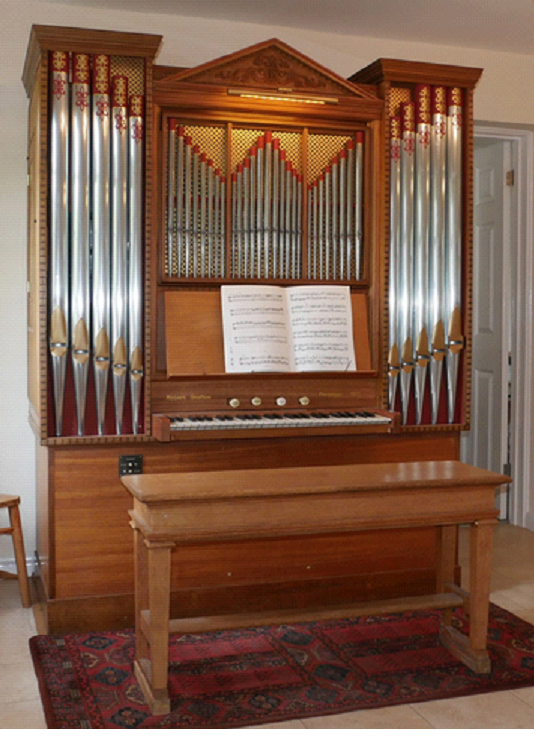
I could have done with a project like these two during lockdown, but that wasn’t to be. Maybe next time…
These organs may not be trains or Meccano, but in some circles, they are equally anoraky! Everyone should have a hobby and be creative in some way.
And finally …
Alec Bray
Ricky Gervais was a member of the Model Railway Club at Ashmead School Reading when I was teachng there: I (and my wife) took a small group, including Ricky, to Pendon Museum one Sunday afternoon, and they came back to our haouse for tea (couldn’t do that nowadays…) So Ricky G nas taken tea with me!


